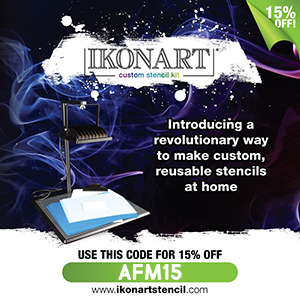Use a custom silkscreen stencil to create a "boo-tiful" pair of Polymer Clay Ghost Earrings!

Looking for something uniquely "boo-tiful" to wear this spooky season? These Polymer Clay Ghost Earrings are the perfect Halloween accessory that anyone of any crafting skill level can make! I really enjoy combining different crafting techniques, and one of my favorites has to be using stencils with polymer clay. The process is easier than you'd think, and I hope you get inspired by this tutorial to try making a pair of Polymer Clay Ghost Earrings for yourself with a custom silkscreen stencil using Ikonart.

To make your own Polymer Clay Ghost Earrings, you will need these supplies:
- Ghost Pattern (for personal use only)
- Ikonart Custom Stencil Kit
- Squeegee
- Polymer Clay - purple, white
- Earring Clay Cutter Set
- Baking Mat or Ceramic Tile
- Clay Roller or Clay Rolling Machine
- Acrylic Paint - white
- Gloss Glaze or UV Resin
- 2 10mm Jump Rings
- 2 Earring Posts
- Strong Adhesive
- Jewelry Pliers
*Save 15% on Ikonart supplies when you shop with code AFM15
Printables, designs, and cut files from Artsy-Fartsy Mama are for personal use only. You may use these files for personal projects, but you may not sell them. If you'd like to share this project digitally, share a link to this post/website only. Do not share a direct link to the file.

The first thing you need to create an Ikonart stencil is a printed design. Download the Ghost Pattern design and print as dark as possible on either inkjet or laser Ikonart Printer Film.
The next step in the process is exposing the stencil film. Set up the exposure stand with UV LED Light by following the directions included in the kit. Ikonart Stencil Film is light sensitive, so be careful to keep it out of sunlight and bright lights before exposure. Cut a piece of the film the slightly larger than the design print.
Lay the piece of film down on the base of the stand with the textured side facing up. Place the printed design on top of the stencil film, making sure it's right-side up.
Lastly, place the clear exposure sheet (found in the stencil film pack) on top and press it down well to seal the design tight against the stencil film. Turn the exposure light on and expose the film for 35 seconds.

The next step in the stencil-making process is to washout, or rinse, the stencil to reveal the image on the film. Clip the exposed stencil film to the Ikonart clipboard with the shiny side (carrier sheet) touching the clipboard. Use a kitchen sink sprayer or TriggerJet Nozzle to rinse the stencil film with warm water until the design shows through the film and becomes completely clear. The washout process usually takes no more than 3 minutes.
Gently blot the excess water from the stencil, and hang or lay the stencil flat to dry for about 45 minutes. When the stencil is completely dry, you shouldn't see any water spots or discoloration.

Use a permanent marker and write the word "back" on the carrier sheet (shiny side) on the back of the stencil or clip one of the corners off of the stencil (as seen above). This helps later when pairing the carrier sheet and the stencil back together when you are done using it.

While the stencil is drying, start working on the earrings. Condition the clay by kneading it with your hands until it becomes soft and pliable. Use a clay roller with rings, clay depth guides, or line 2 craft sticks parallel to each other with the clay in between to evenly flatten the clay to about a 3mm thickness.
Tip: If you work directly on a baking mat or ceramic tile, you don't have to worry about transferring your project to an oven-safe surface when it's time to bake the clay or accidentally misshaping or dropping the clay in the process.

Remove the carrier sheet from the back of the stencil and place the stencil over the clay. Rub it down gently with your fingers or use the roller to make sure the stencil is pressed down well and that there aren't any air bubbles trapped underneath.

Add a small line of acrylic paint at the edge of the stencil. Use a squeegee to gently pull the paint across to the opposite edge. Don't press hard, just skim over the top of the stencil. Scrape the excess paint away and put it back into the paint bottle.

Slowly lift the stencil up to reveal the painted pattern underneath. If you see any missed spots while peeling the stencil away, carefully lay the stencil back down and add a little more paint over the area.
If everything looks good as you get to the end of the stencil, remove the stencil completely. Let the paint dry on the clay before moving on to the next step (don't worry - it doesn't take long). Wash the stencil well following the instructions below.
Washing Stencils:
For best results, wash stencils while the paint is still wet. To wash your stencil so that it can be used again and again, first get the clipboard wet so your stencil doesn't stick to it. Place the stencil on the clipboard with the textured side up, and lightly rub the stencil under cold running water to remove all the paint.
Do not rub or scrub the adhesive side of the stencil, and NEVER use anything other than water to wash the stencils. To prevent the stencil from breaking down, don't ever leave the stencils to soak.
Remove the stencil from the clipboard and lay it down with the adhesive side up. While the stencil is still wet, place the carrier sheet onto the stencil so that the word “BACK” is readable. Hang or lay the stencil flat to dry completely.

Cut two pieces (per earring) using the larger clay cutter. Place the cutter over the clay and press it straight down, and then gently pull the cutter straight up. If the clay stays down, leave it there. If it comes up with the cutter, be careful how you remove it. Poking through the top to push the clay out can leave dents or misshape the piece.
Here's a few tricks & tips for cutting clay that have worked for me:
- Place a piece of plastic wrap over the clay first, and then cut the clay.
- Dip the cutter in corn starch or talcum powder before cutting
- Your clay or workspace might be too warm. Put the clay in the fridge or freezer to cool it down before cutting.

Carefully peel away the excess clay, leaving the pieces in place (I had extra space on my clay, so I cut some other earrings at the same time). It's ok if the edges look a little rough. Just make sure to remove all of the excess clay.

Use a toothpick or a small circle cutter to make holes at the top end of the earring pieces to be able to easily connect the earring pieces later.

Next, roll out a small piece of white polymer clay the same way (and thickness) as the purple clay. Use the smaller clay cutter to cut a top for each earring. Use the tips I shared above for cutting the clay successfully.
Just like the other earring pieces, use a toothpick or a small circle cutter to make holes at the bottom end of the earring pieces to easily connect them together later.

Preheat your oven and bake the earring pieces. Most polymer clays are usually baked at 275º for 15 minutes per quarter inch thickness, but refer to your specific clay packaging directions. Once baked, let the pieces cool completely before handling.
Use a fine sandpaper to clean up the edges of the earring pieces.

To give the earrings a shiny and professional-looking finish, apply a coat of gloss glaze or UV Resin to the surface with a toothpick.
If using glaze, apply it to the clay in thin coats (30 minutes between each coat). Give the earrings 24 hours to dry completely.
If using UV resin, apply a thin coat over the earrings, and cure under a UV light according to package directions.

Turn the top earring pieces over, and attach an earring post to the center using strong adhesive or UV resin.

Use pliers to open a 10-12mm jump ring for each earring. Hook the rings through the holes in the earring sets to connect them together. Close the jump rings with the pliers.

Aren't these earrings BOO-tiful?! I LOVE how they turned out, and can't wait to wear them all spooky season long. I definitely could NOT have made them without the help of my Ikonart kit! If you try making some of these Polymer Clay Ghost Silkscreen Earrings, I would love to see them! Leave me a comment, or tag a photo on Facebook, Twitter, or Instagram! #AFMcrafts
Don't forget to Pin, Like, and Share!












